What is alcoholism?

Alcoholism is a compulsive urge to drink alcohol even when it causes various problems and complications. In this condition, a person attempts to stop drinking, but their efforts are generally unsuccessful. Alcoholism develops gradually and it harms a person’s physical and mental health and well-being, as well as other aspects of life.
Early signs of alcoholism include the inability to limit alcohol intake even when deciding to have a few drinks and stop there. Friends and family usually comment on drinking behavior and a person suffers from hangovers quite frequently.
As a person moves to more problematic alcohol use and develops alcoholism, the symptoms become more serious. For example, they find it even harder to limit alcohol consumption and experience serious withdrawal symptoms when not drinking alcohol.
A person becomes frustrated or irritable when not being able to drink at a specific time or occasion. They change their social circle and spend more time with people who drink a lot. It’s not uncommon for a person with alcoholism to use drugs and other substances.
Stages of alcoholism include occasional use with binge drinking episodes, a period of increased or regular drinking, problem drinking, dependence, and then alcoholism or alcohol use disorder. Although alcohol harms a person’s life in many ways, it is possible to recover from this addiction. The most common treatment methods for alcoholism include behavioral therapies, medications, and support groups. A combination of different approaches usually works best. A strong support system plays a major role in recovery from alcoholism.

What is alcoholism?
Alcoholism, or alcohol use disorder (AUD), is a term that refers to an addiction to alcohol. An affected individual has a compulsive need to continue drinking alcohol regularly and in large amounts despite the harm it causes.
Alcoholism isn’t a type of disorder that develops overnight; it evolves gradually. In many cases, a person starts as a social drinker and becomes a heavy drinker later on.
In 1956, The American Medical Association recognized alcoholism as a disease based on the theory that addiction to alcohol and excessive drinking result from an illness that influences the structure and function of the brain.
Four years before, in 1952, the American Psychiatric Association’s first edition of the Diagnostic and Statistical Manual of Mental Disorders (DSM) identified the term addiction with subcategories including drug addiction and alcoholism.
For many years, the term alcoholism was mainly used to describe dependence on alcohol. There was a clear distinction between alcohol abuse and alcohol dependence in DSM-4. In May 2013, DSM-5 integrated two disorders into a single disorder – alcohol use disorder and classified it in terms of intensity.
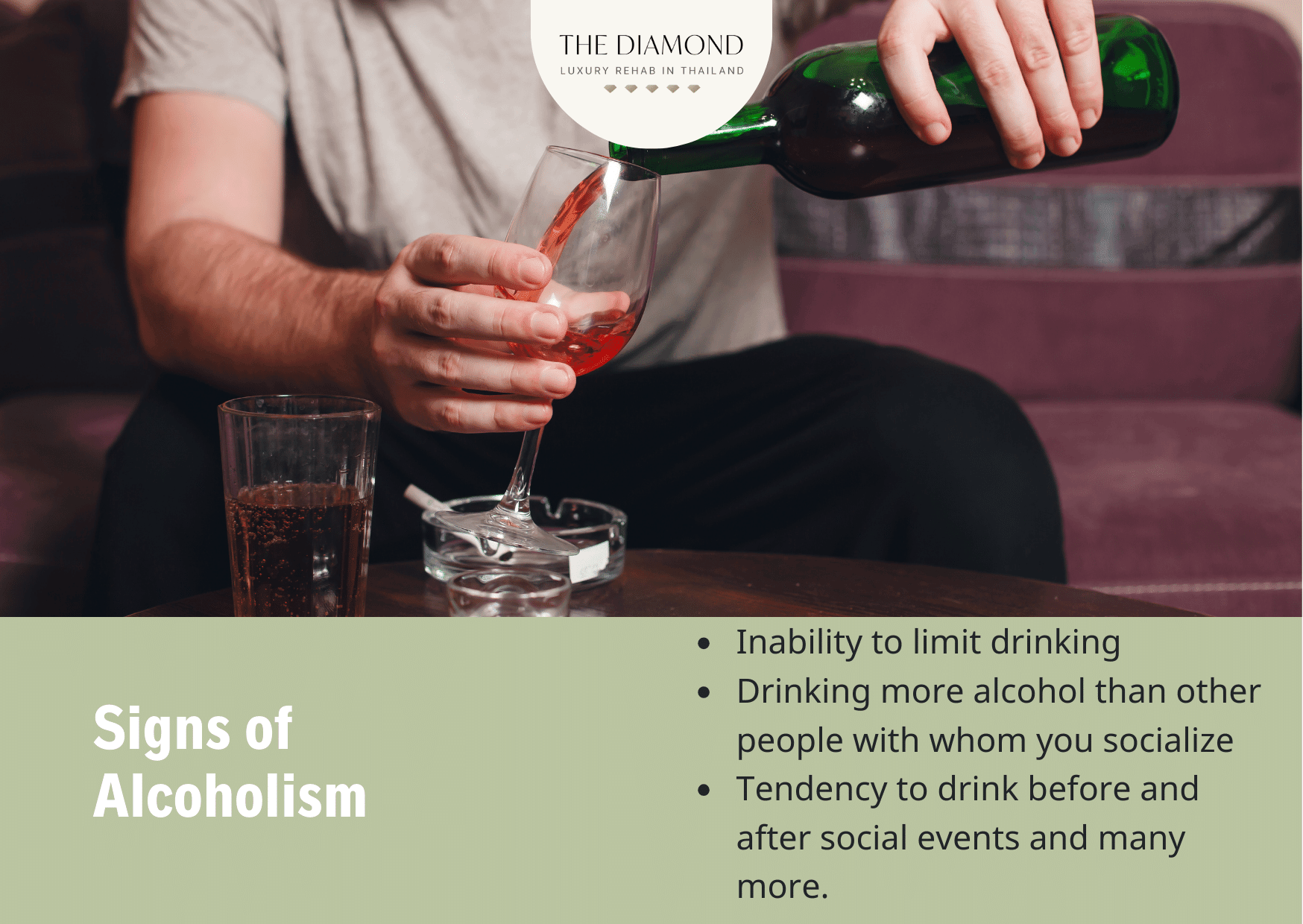
What are the signs of alcoholism?
Signs of alcoholism include a variety of behavioral, physical, and psychological indicators that indicate a person is suffering from an alcohol use disorder. The early signs of alcoholism are listed below.
- Inability to limit drinking
- Drinking more alcohol than other people with whom you socialize
- Tendency to drink before and after social events
- Being hangover frequently
- Family, friends, and coworkers starting to comment on your drinking behavior
- Frequent binge drinking sessions
- Experiencing cravings for alcohol when not drinking
What are the symptoms of alcoholism?
Symptoms of alcoholism include a variety of emotional, physical, and behavioral signs that all point to the existence of an alcohol use disorder. The most common symptoms of alcoholism are listed below.
- Finding it extremely hard to limit drinking
- Drinking alone or in secret
- Withdrawal symptoms when not drinking
- Strong cravings to drink alcohol
- Storing alcohol in unlikely places
- Expressing violent or aggressive behaviors when others express concerns about drinking habits
- Blacking out and inability to remember what happened the night before
- Spending a lot of time drinking or thinking about and planning to drink
- Losing interest in hobbies and activities previously enjoyed
- Having drinking rituals
- Irritability when someone interrupts the drinking rituals
- Nervousness and frustration when not being able to drink in a specific situation
- Drinking alcohol to feel good or deal with stress and other negative emotions
- Building tolerance and needing more alcohol to experience pleasurable effects
- Experiencing work or school problems due to alcohol drinking
- Financial and legal troubles due to alcohol drinking
- Engaging in risky activities and behaviors under the influence of alcohol
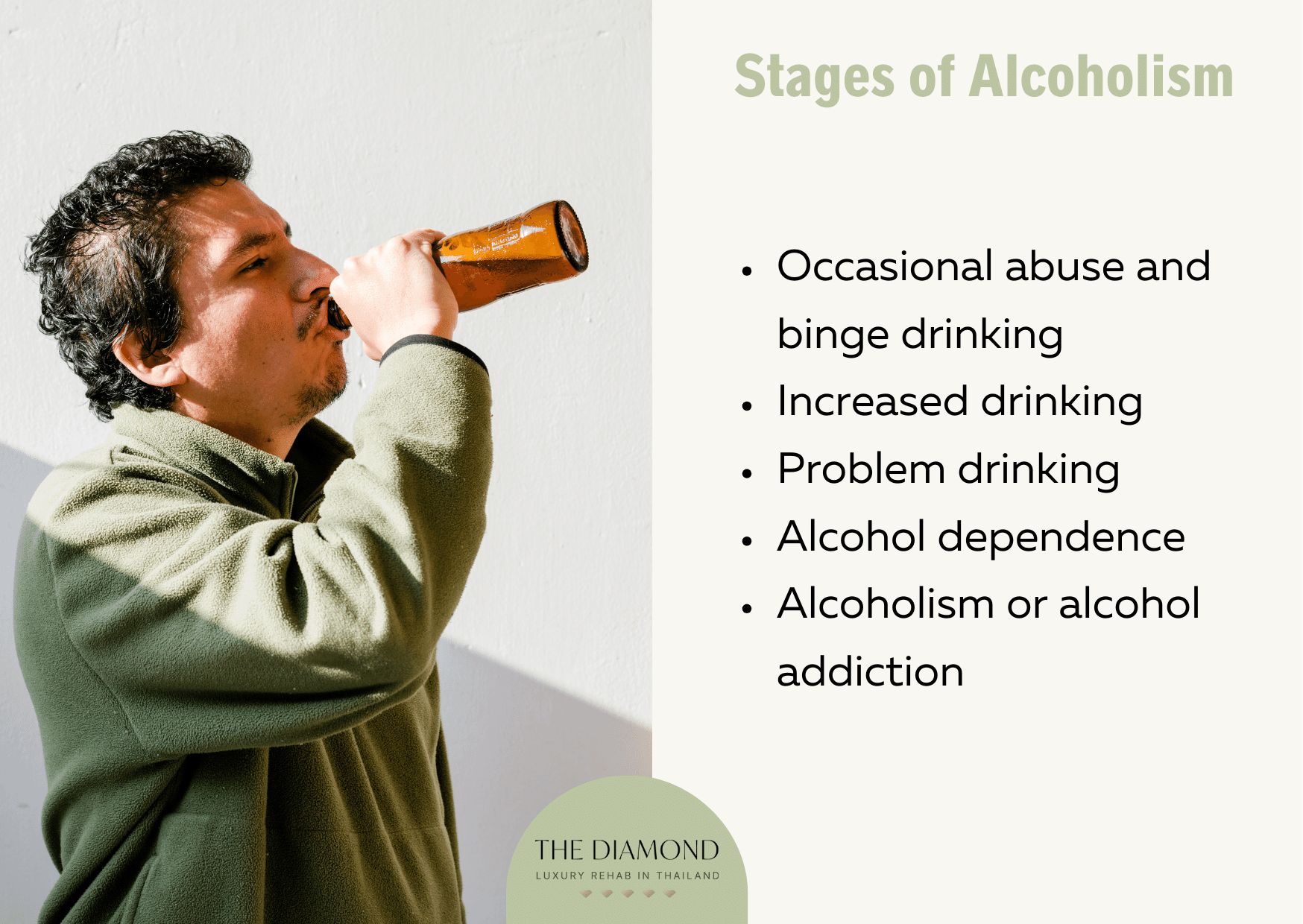
What are the stages of alcoholism?
Stages of alcoholism describe the process through which a person moves from occasional drinking to addiction. All the stages of alcoholism are listed below.
- Occasional abuse and binge drinking: Starts with experimentation with alcohol mostly among young adults. Experimental drinkers often engage in binge drinking sessions. Even though they don’t drink regularly, these individuals still consume large amounts of alcohol. The main characteristics of binge drinking are the consumption of at least five drinks within two hours among men and a minimum of four drinks in two hours for women. Several people exceed these amounts.
- Increased drinking: This stage entails more frequent consumption of alcohol. A person in this stage is no longer experimenting with alcohol. Certain people increase drinking due to boredom, stress, sadness, or loneliness, and as an excuse to socialize with friends. Generally speaking, increased drinking has a strong emotional component i.e. people up their alcohol intake to feel better about something.
- Problem drinking: Problem drinking refers to cases when an individual starts experiencing negative effects of their alcohol drinking behavior. They tend to lose sleep or become anxious and more depressed. While alcohol makes them feel sick, they like the pleasurable effects too much to care about at this point. Numerous individuals at this stage engage in risky activities such as drunk driving or participating in other dangerous behaviors under the influence. Different issues occur at this point, including relationship problems, difficulty conversing with other people, erratic behaviors, reduced social activity, and sudden changes in social circles. An affected individual spends a lot of time with other people who similarly drink alcohol a lot.
- Alcohol dependence: In this stage, a person is dependent but still not addicted to alcohol. Dependence stems from problem drinking. In this stage, an individual has an attachment to alcohol, experiences problems in daily life, and is well aware of all the negative effects. However, they are unable to control their alcohol intake. This happens because they build tolerance and need more alcohol to experience the same desired effects. People additionally experience alcohol withdrawal syndrome symptoms such as difficulty sleeping, heart racing, sweating, severe irritability, body tremors, and nausea that aren’t related to being hungover.
- Alcoholism or alcohol addiction: The final stage describes the physical and psychological need to drink. In other words, a person doesn’t drink solely for pleasure anymore. Individuals with alcoholism physically crave alcohol, develop compulsive behaviors, have strong withdrawal symptoms, and possibly even abuse other substances as well.

What are the treatments for alcoholism?
Treatments for alcoholism include detox and withdrawal, behavioral therapies, medications, and support groups. In most cases, a combination of different approaches works best.
Patients receive treatment in inpatient or residential and outpatient settings. Inpatient programs are most suitable for persons whose alcoholism is moderate to severe. A patient lives in a treatment facility during a specific timeframe e.g., 30, 60, or 90 days. This type of program is particularly useful for persons without a strong support system or those who need a more structured environment to stop drinking.
On the flip side, outpatient programs are most suitable for persons with mild to moderate alcohol addiction. They’re useful for individuals who complete inpatient treatment and need support or structure to continue a substance-free lifestyle. In this case, patients attend therapy and counseling sessions regularly, but they’re able to maintain personal and professional life and sleep at home.
The first stage of alcoholism recovery is detoxification (detox) during which a patient stops drinking alcohol. Abrupt cessation of alcohol consumption causes withdrawal symptoms. For that reason, detox is medically supervised.
While detox and alcohol withdrawal timelines vary from one patient to another, in most cases, mild symptoms of withdrawal occur six to 12 hours after the last drink. Mild withdrawal symptoms include headache, mild anxiety, small tremors, insomnia, and gastrointestinal issues.
About 24 hours after the last drink, people experience tactile, visual, or auditory hallucinations alongside other withdrawal symptoms. In most cases, these symptoms achieve their peak within 72 hours after the last drink.
Depending on the severity of alcoholism, certain patients report experiencing more persistent withdrawal symptoms. That’s why this process must be medically supervised. While it’s easy to assume a person is able to do it on their own, medical supervision offers a safer environment and greater chances of success.
The main purpose of behavioral treatments is to change drinking behavior and thought patterns through counseling. During regular counseling sessions, a patient learns to identify negative thoughts and behavior patterns in order to replace them with positive alternatives or increase motivation to change. This approach focuses on uncovering triggers that contribute to drinking and helping patients adopt healthier coping techniques.
In 2019, the journal Science Advances published a paper by Witkiewitz et al., which confirmed that various behavioral and psychological treatments are available for persons with alcoholism. Treatment approaches with the greatest efficacy include cognitive-behavioral therapy (CBT), motivational interviewing, and contingency management, in addition to 12-step programs.
The role of CBT is to help patients identify negative thoughts and behavior patterns whereas motivational interviewing focuses on increasing a patient’s motivation to make positive changes in their life. On the other hand, contingency management reinforces desired behavior through incentives.
These behavioral approaches increase awareness of high-risk situations and help patients cope with negative stimuli in a healthier manner. That way, they don’t use alcohol to feel better or to escape from specific problems anymore. Behavioral therapies additionally provide life skills training and communication training.
The abovementioned therapies include individual and group sessions. Both settings provide their unique benefits and are important to recovery from alcoholism.
Mutual support groups prove to be an effective approach to the treatment of alcoholism, even in cases when a person receives no other formal treatment. Attending support group meetings helps patients reduce alcohol intake and achieve sobriety.
Keep in mind that formal treatment provides better chances of successful recovery. However, support groups are an excellent starting point as well. What makes them so beneficial is that people in the same situation (alcoholism) share their experiences regarding addiction and recovery. Support groups allow patients to receive much-needed understanding and support in order to extend the same help to others.
When it comes to medications for alcoholism, it’s important to remember that not every person needs them. Medications are prescribed when it is necessary, and patients take them for a specific period.
Medications prescribed for the treatment of alcoholism include disulfiram (Antabuse), naltrexone (ReVia), naltrexone injection (Vivitrol), and acamprosate (Campral).
Disulfiram works by inducing an uncomfortable physical reaction in response to drinking alcohol. So, when a person drinks, they are likely to experience nausea and vomiting, chest pain, headache, anxiety, weakness, and difficulty breathing, a 2018 article written by Kimberly Holland for Healthline reports.
Naltrexone in both oral and injection forms decreases the urge to drink and prevents excessive alcohol intake. In other words, these medications block the feel-good response to alcohol. Without satisfying feelings after drinking, a person is less likely to continue with alcohol intake. Acamprosate is prescribed for patients who need to stop drinking and to help with cognitive function.
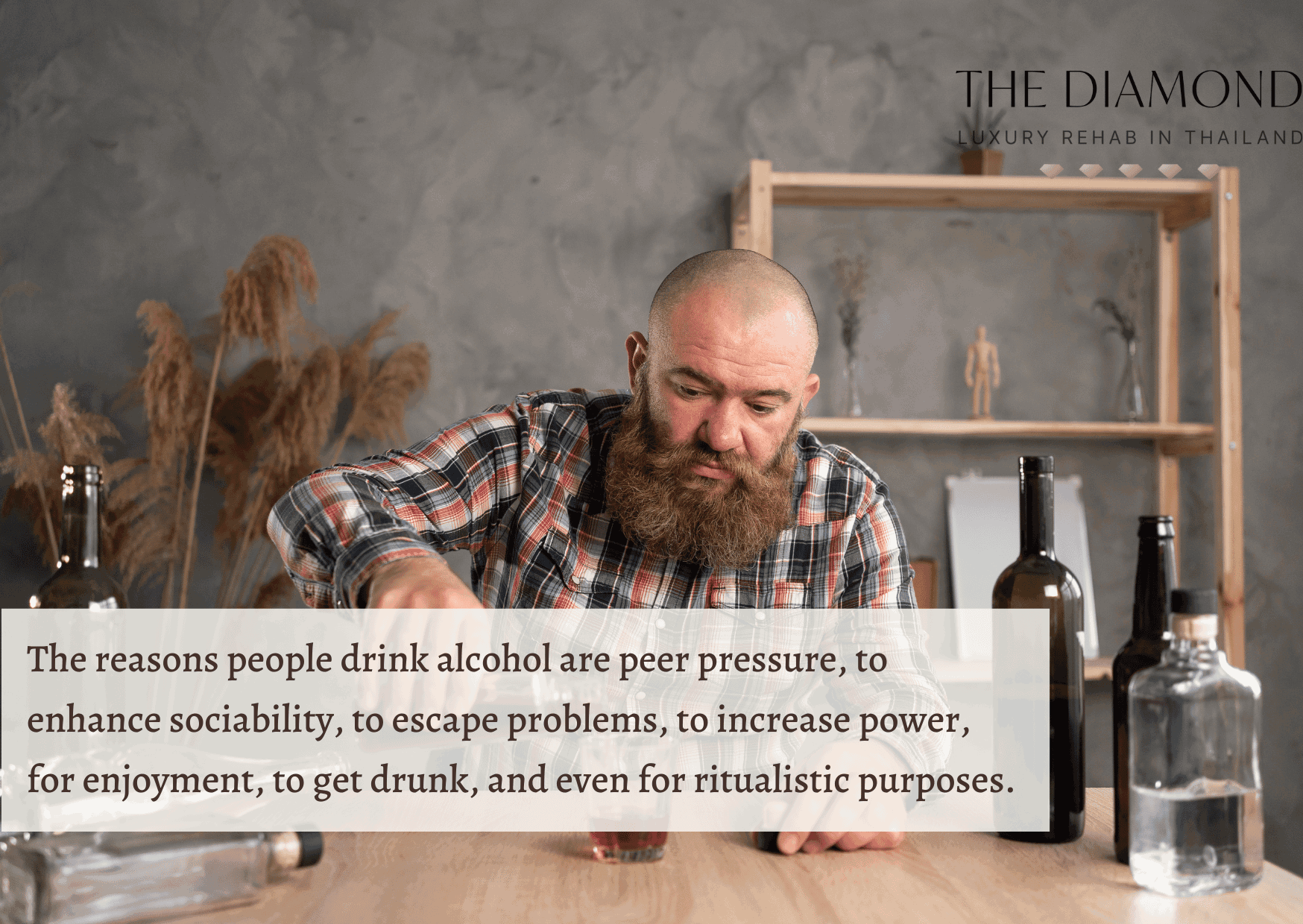
Why do people drink alcohol?
The reasons people drink alcohol are peer pressure, to enhance sociability, to escape problems, to increase power, for enjoyment, to get drunk, and even for ritualistic purposes. Certain people use alcohol to tackle symptoms of trauma, depression, anxiety, or other mental health disorders. They see alcohol as a tool to “numb” those symptoms, but in reality, it worsens them.
A 1993 paper by Abbey et al., from the journal Addictive Behaviors reports that despite various reasons for drinking, there are two main categories of motivation.
The first category includes drinking for negative reinforcement. Alcohol is used by people as a coping mechanism and as a means of avoiding, controlling, or escaping uncomfortable feelings.
The second category includes drinking for positive reinforcement. In this case, a person drinks to be more sociable, to have a good time, and to celebrate a specific occasion or event.
Heavy drinkers are more likely to drink to cope than infrequent drinkers. In other words, persons with alcoholism are more inclined to use alcohol to combat negative thoughts and emotions.

How long does alcohol stay in your system?
How long alcohol stays in the system depends on blood alcohol concentration (BAC) i.e. the amount of alcohol in the blood in relation to water content. The average time it takes for the body to metabolize a small liquor shot is one hour. Two hours are necessary to metabolize a pint of beer, whereas a large glass of wine takes three hours. Having a few drinks takes several hours to metabolize.
Alcohol detection time varies based on the test and body system used. For instance, the tests measure the presence of alcohol in the blood for up to six hours. A breath test detects alcohol use within 12 to 24 hours. Urine tests detect the presence of alcohol up to 12 or 24 hours after the last use, but newer tests and technologies raise this limit to 72 hours. According to a 2021 article titled, “How Long Does Alcohol Stay in Your System?” from the Cleveland Clinic, the biomarker phosphatidylethanol (PEth), which indicates alcohol consumption, can be detected in urine for a duration of 14 days.
Testing saliva detects alcohol use 12 or 24 hours after the last drink. A hair test has the longest detection time and it shows traces of alcohol in the system up to 90 days after the last drink.
Various factors influence BAC and how long it takes to metabolize alcohol. These factors include weight, age, liver disease, medications, drinking on an empty stomach, and the frequency and amount of alcohol consumed (e.g. binge drinking).
Around 20% of alcohol from a single drink goes straight to the blood vessels, from where it moves to the brain. The remaining 80% travels to the small intestine. From there, alcohol reaches the bloodstream as well.
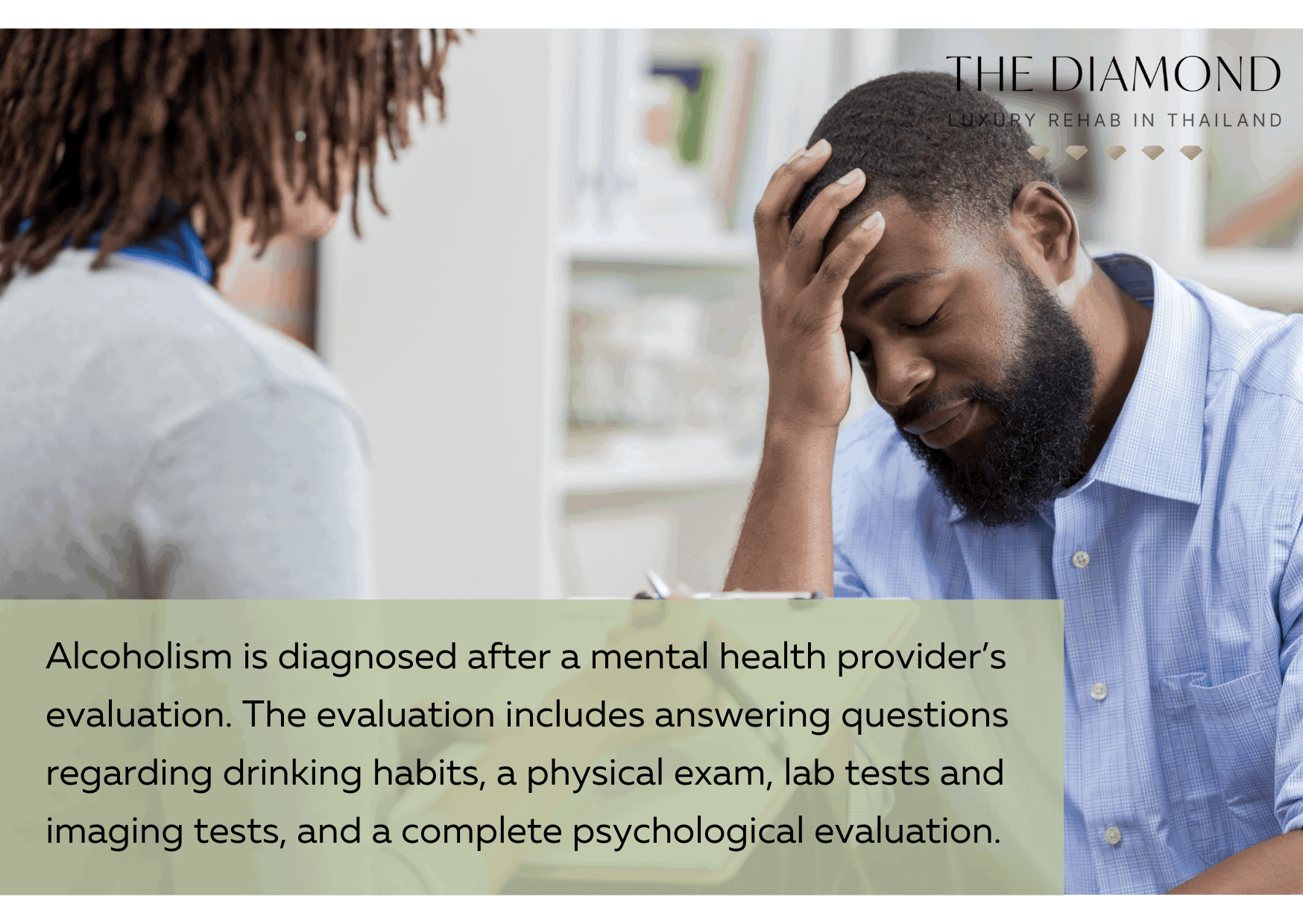
How is alcoholism diagnosed?
Alcoholism is diagnosed after a mental health provider’s evaluation. The evaluation includes answering questions regarding drinking habits, a physical exam, lab tests and imaging tests, and a complete psychological evaluation.
The main purpose of the evaluation is to uncover whether a person meets the criteria that classify their alcohol drinking habits as AUD. After all, not every person who drinks is automatically an alcoholic.
According to a 2022 article titled, “Alcohol use disorder” from Mayo Clinic, the provider may request consent before engaging in conversation with friends or family. Confidentiality laws, however, forbid one’s provider from disclosing any of the patient’s information without their permission.
A physical exam is necessary because alcoholism has physical consequences too. Certain physical changes indicate complications of alcohol use. During a physical exam, patients answer questions about their health.
Although no specific test diagnoses AUD, lab results are one way to determine the presence of alcoholism. A healthcare professional is likely to order tests to identify health problems associated with alcohol use and evaluate the extent of damage caused by alcoholism.
Finally, a complete psychological evaluation involves questions that patients need to answer about their feelings, thoughts, symptoms, and behavior.
Once a mental health specialist diagnoses alcoholism or AUD, they proceed to determine the stage of the disorder. According to an article titled, “Alcohol Use Disorder: A Comparison Between DSM–IV and DSM–5” last revised in 2021 by the National Institute on Alcohol Abuse and Alcoholism (NIAAA), two to three symptoms indicate mild alcoholism. Four to five symptoms point to moderate AUD, whereas six or more symptoms represent severe AUD.
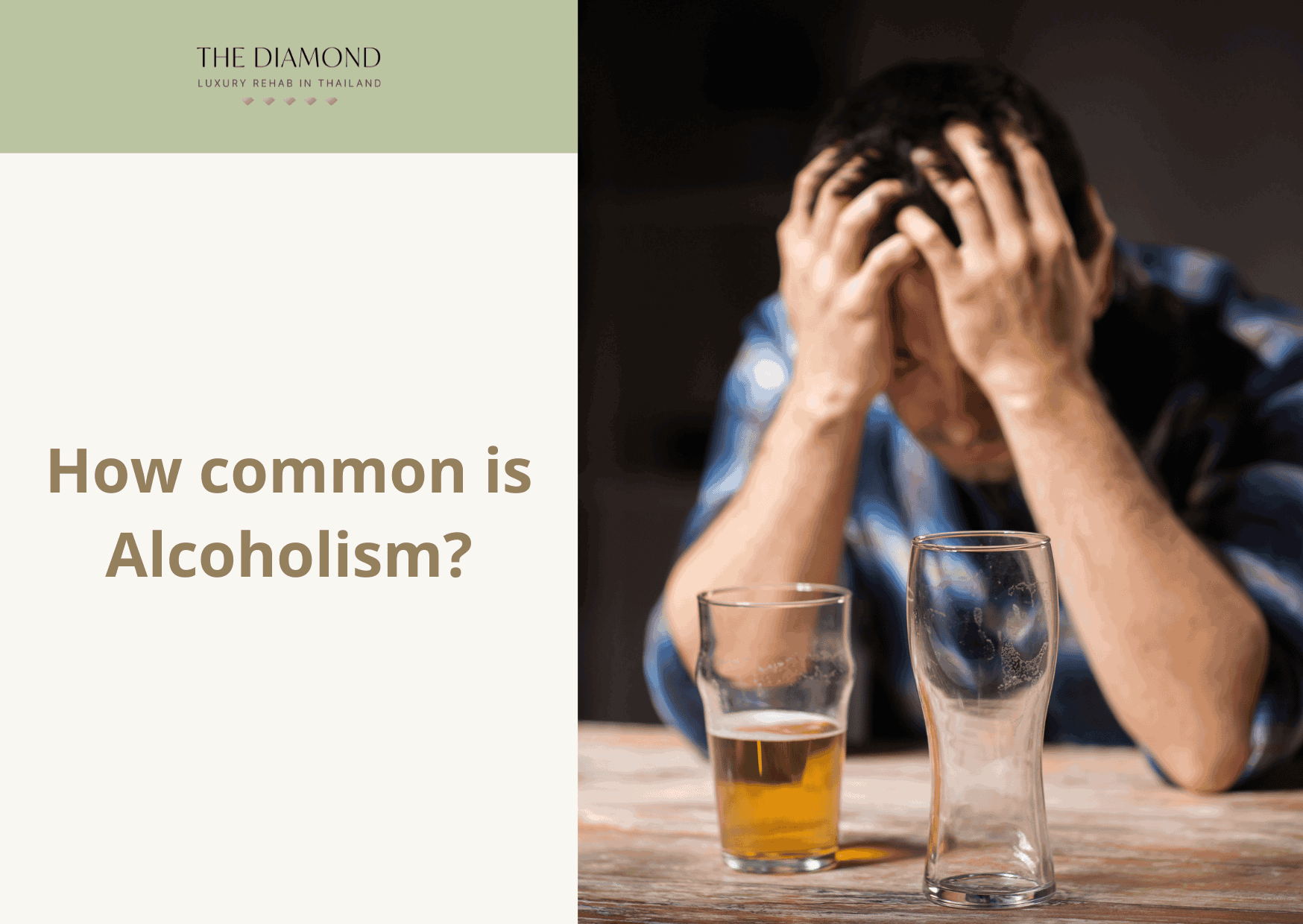
How common is alcoholism?
Alcoholism and problematic use of alcohol are widespread. According to a fact sheet titled, “Alcohol” published in May 2022 by the World Health Organization (WHO), the harmful use of alcohol leads to 3 million deaths annually.
On a global level, 107 million people have an AUD. When it comes to the United States, 29.5 million people ages 12 and older had AUD in 2022, according to the National Institute on Alcohol Abuse and Alcoholism (NIAAA)’s National Survey on Drug Use and Health. Of these, 17.4 million accounts for men, and 12.2 million include women. In other words, alcoholism is more prevalent in males than females. Additionally, around 753,000 adolescents aged 12 to 17 had AUD in the same year. Prevalence of alcoholism among adolescents is more common in females than males affecting 472,000 and 281,000 teens, respectively. Adolescents are most likely to be quickly affected by alcohol, which explains why the use of alcohol in the early years is strongly associated with developing alcoholism later on.
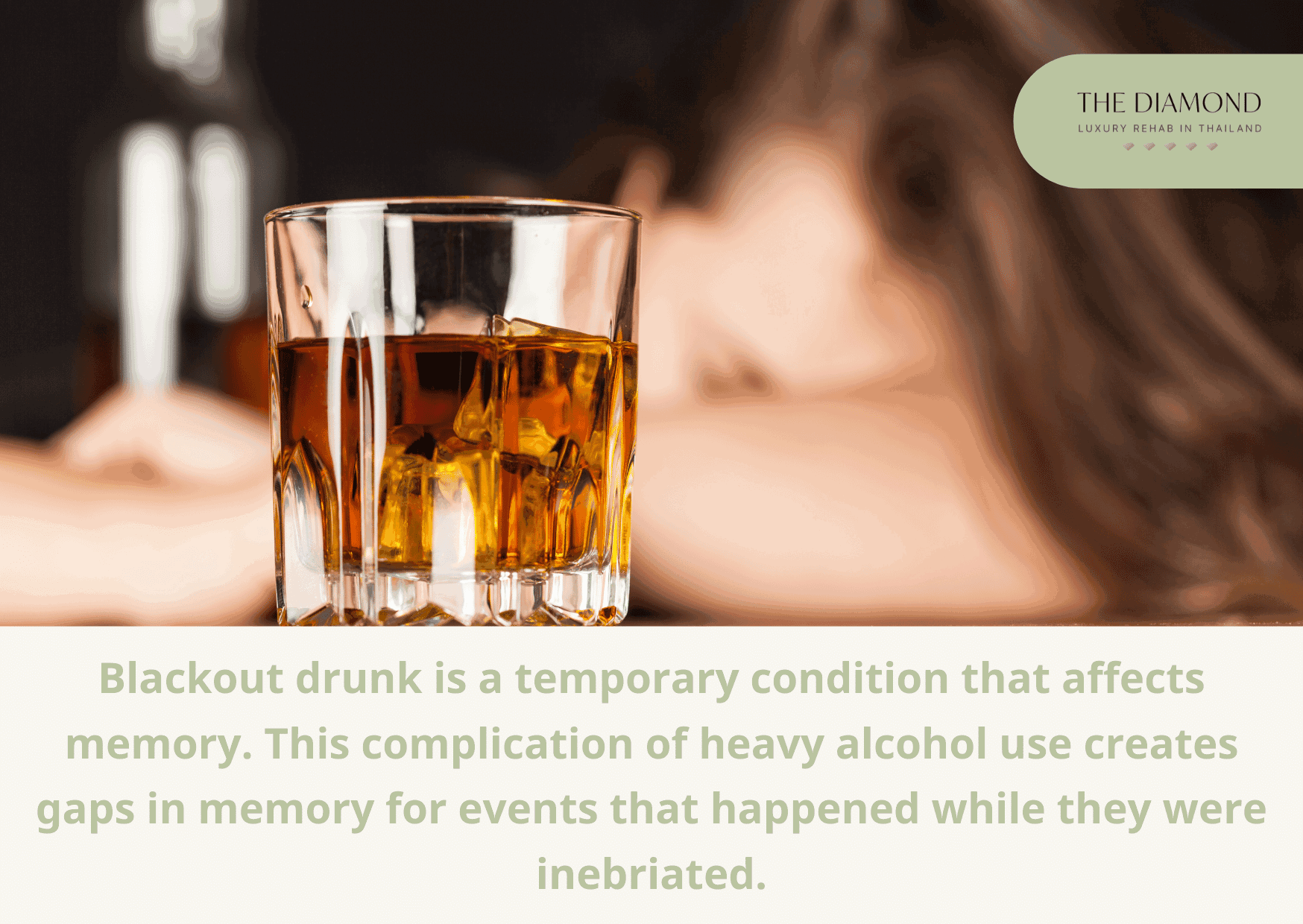
What is blackout drunk?
Blackout drunk is a temporary condition that affects memory. This complication of heavy alcohol use creates gaps in memory for events that happened while they were inebriated. The blackout happens because alcohol temporarily blocks memory consolidation i.e. transfer of memories from short-term to long-term storage in the hippocampus. A person experiences a sense of lost time when they are black out drunk.
Can you drink amoxicillin and alcohol?
Yes, you can drink amoxicillin and alcohol, but this is not the wisest idea. Generally speaking, moderate consumption of alcohol doesn’t impair the effects of amoxicillin. However, most doctors advise patients to avoid drinking while on antibiotics, including amoxicillin. By avoiding alcohol, the body is more capable of fighting the infection. Additionally, antibiotics and alcohol cause similar adverse reactions such as dizziness, stomach upset, and drowsiness. Taking them together increases the likelihood of side effects. When not sure, consult a physician about alcohol use while taking antibiotics.
Can you drink Xanax and alcohol?
No, you can’t drink Xanax and alcohol. Combining anxiety medications and alcohol worsens the side effects of these medications, such as extreme sleepiness, slowed breathing, and difficulty concentrating.
Alcohol and Xanax are a potentially dangerous combination. Healthcare professionals strongly recommend avoiding alcohol when taking this and similar medications.

